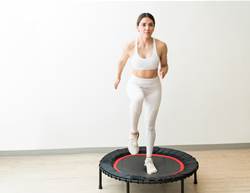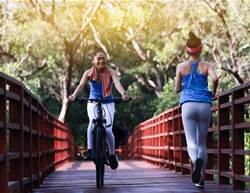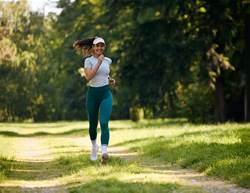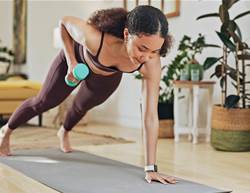We’ve seen our fair share of health trends in the last year. We’ve asked experts about the 75 Hard Challenge, mouth taping and the latest fad diets. And we can’t wait to see the positive health developments and keep you updated on the less-than-trustworthy trends over the next year.
Looking ahead, we asked a range of health experts for their health trend predictions for 2025.

Running
Our socials have been full of friends joining running clubs (our favourite was the running-bakery trend, even if it seems a bit counterintuitive).
“Running became really popular during lockdowns as it was a way for people to get out of the house and stay active. However, it wasn’t until this year that running events started to boom again, so now not only are people running for fitness and their mental health, but they are also training with an event in mind,” says Ben Lucas, Director of Flow Athletic
“I personally love a running event as it is a great vibe, a fun day out with friends and it allows you to put your training to the test. It is also motivating and a great reason to stick to your training plan as there is a specific date that you need to be ready by.”
And what’s not to love? Running is convenient, free and has lots of health benefits. Read more about getting motivated to run by Tim Robards.

Longevity
Longevity was one of the key trends in The 2024 Global Wellness Summit Trends Report and Lucas points out this trend is still going strong. At Prevention, we’ve also seen interest in this topic rise in popularity in medical research and have covered various healthy habits said to increase your chances of living longer, including regular exercise (including simple exercise like walking) making friends, and certain diets. We even reported on 8 habits that could add up to 24 years to your life.
“The idea is that while many of us are living longer, we are not living in a healthier state, and therefore focusing on things that will help us live healthier for longer is key,” says Lucas.
For some, this might mean trying a Mediterranean diet, focusing on recovery or starting a new exercise routine.

Curious walks
Curious walks are a good way to make your stroll more relaxing.
“Mindful walking isn’t anything new however, a lot of people get confused as to what mindful walking is. A curious walk takes the guesswork out of mindfulness and turns it into more of a tangible way to practice mindfulness when walking,” says Luck McLeod, founder of meditation app Soul Alive and author of Everyday Enlightenment.
So how exactly do we do a curious walk? “All you need to do is notice three things you’ve never noticed before on your walks. It could be the same walk you do every day around your neighbourhood or your commute to work, but each time you do it now try to notice three new things each time you do the walk," says McLeod.
“It doesn’t matter how mundane they are. Doing this pulls the mind out its constant thinking or worrying mode and into connection with the present moment, which is refreshing for your mental wellbeing,” says McLeod.
If you’d rather try mindfulness at home, try these techniques from McLeod.
Tracking sleep
From sleep trackers and new insomnia research to sleep tourism, we’re all very concerned with getting quality shut eye. Not without reason, either, given sleep impacts everything from our mood to our immune system. Not getting enough sleep is linked with an increased risk of chronic health conditions.
“I predict that in 2025 [tracking the quality of your sleep] will become a lot more detailed and commonplace," says Lucas. "Sleep is the ultimate form of recovery and with an increasing focus on all things recovery, it just makes sense that improving the quality of our sleep will rise to the top of importance."
This might play out with a rise in using meditation apps, sleep supplements and medications, and sleep trackers.

Contrast therapy
Forget cold plunges, now it’s all about shifting from hot to cold treatments. This might bring to mind the centuries-old practice of running between a wooden sauna hut and rolling in the snow in Finland. There are just 3,000 posts on contrast therapy on TikTok currently but we predict that's about to boom.
“By combining heat, which relaxes muscles and increases circulation, with cold, which reduces inflammation and tightens blood vessels, contrast therapy delivers benefits for both recovery and overall health,” believes Melanie Hartskeerl, naturopath at Wildsoul Wellness.
Contrast therapy may be helpful in easing inflammation and stiff joints. Some people also believe it boosts the immune system and boosts circulation, though more research is needed.

Pilates
We featured reformer Pilates in a health trend piece back in 2023. And broader Pilates continues to be one of the most popular group exercise options available. According to PureGym's analysis of Google search results, Pilates is the top exercise in 40 countries, including the UK, Portugal, Poland, the US, Australia and New Zealand.
“Pilates is not only a low-impact workout, but it also helps to improve your posture, core strength and bone density and corrects muscle imbalances. These benefits are essential for good health at any age, but as we reach perimenopause, it becomes especially important,” says Sam Mostardo, Pilates instructor at Club Pilates.

Sensehacking
“Sensehacking is a trend that sees people deliberately manipulating their sensory environment in an attempt to enhance their personal wellbeing," says psychologist Dr Maria-Elena Lukeides from The Wellness Fountain.
It involves looking all five core senses -– sight, hearing, smell, taste, and touch, with the knowledge that these senses directly impact our perception of the world (and can be harnessed to improve overall wellbeing).
"The sensehacking technique, coined by Oxford University Professor Charles Spence, uses various sensory inputs to influence emotions and improve social, cognitive and mental health. An example of sensehacking is embracing natural light in the morning to help set your circadian rhythm, or using calming colours like blues in your workspace to reduce stress," says Lukeides.
As a psychologist and qualified breathwork facilitator, I’m seeing the act of sensehacking being used in conjunction with people’s breathwork practices, for example, tapping into the power of sound through music to help temper moods or create an ambience that puts someone in a calmer state while they practice their breathwork.”


.jpg&h=90&w=90&c=1&s=1)







